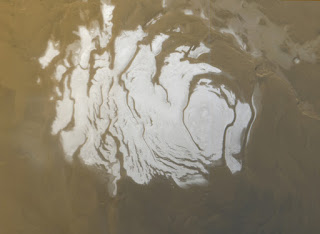Topics: Mars, NASA, Planetary Science, Space Exploration
Mars Close Approach is July 31, 2018
That is the point in Mars' orbit when it comes closest to Earth. Mars will be at a distance of 35.8 million miles (57.6 million kilometers). Mars reaches its highest point around midnight -- about 35 degrees above the southern horizon, or one third of the distance between the horizon and overhead. Mars will be visible for much of the night.
By mid-August, Mars will become fainter as Mars and Earth travel farther away from each other in their orbits around the Sun.
Miss seeing Mars Close Approach in 2018? The next Mars Close Approach is Oct. 6, 2020. [1]
*****
A radar instrument on a European mission to Mars has discovered liquid water beneath the red planet’s south polar ice cap, raising intriguing possibilities for both astrobiology and studies of Mars’ past climate. The discovery of liquid water on Mars has huge consequences for the search for life on the red planet, and could also unveil characteristics of the ancient environment in which it formed before the water was covered with ice.
 |
| What lies beneath: liquid water has been discovered below Mars’ south polar ice cap by an instrument on the European Space Agency’s Mars Express orbiter (Courtesy: NASA) |
We already know that Mars was once a wet planet and that its climate billions of years ago could support large amounts of liquid water – as shown by the myriad ancient river channels, floodplains and lake beds that can be seen on its surface. Today, however, the temperature and pressure at the planet’s surface is too low to permit the existence of liquid water. In 2006 planetary scientists operating the camera on board NASA’s Mars Global Surveyor observed changes in gullies that they attributed to liquid water flows, but the HiRISE camera on the Mars Reconnaissance Orbiter has since revealed that these flows are small avalanches of dry material instead. [2]
1. Mars in our Night Sky, NASA Science: Mars Exploration Program
2. Liquid water discovered beneath Mars’ south pole, Planetary Science Research Update, Physics World
Comments